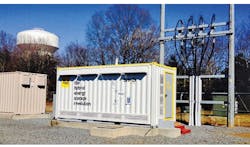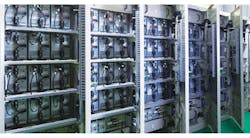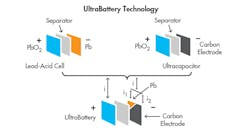Today, supercapacitors are found in many electronic applications. In automotive applications alone, they are used in startup systems, energy recovery solutions, and fast charge-discharge systems, to name a few. Supercapacitors can charge/discharge quickly without losing energy storage capacity over time. They also have very high power density. In contrast, batteries can store larger amounts of energy but they have a defined cycle life. A combination of batteries and supercapacitors results in a hybrid energy storage system that could help meet the needs of myriad renewable energy applications.
Supercapacitors can assist in delivering peak power while improving the performance of batteries in energy storage systems. Many supercapacitor manufacturers, utility companies, and researchers are developing hybrid capacitor-battery energy storage systems for future projects. Some are already using them in case studies and pilot projects, such as the one built by Duke Energy at its Rankin Substation in Gaston County, N.C.
Duke Energy partnered with Aquion Energy, Maxwell Technologies, and others to build a hybrid energy storage system (HESS) project. The hybrid system uses Maxwell’s UCAPs to help manage solar smoothing events in real-time—particularly when the solar power on the grid fluctuates due to cloud cover or other weather circumstances. The Aquion batteries are used to shift solar load to a time that better benefits the utility. The hybrid energy storage system integrates patented energy management algorithms.
The Maxwell UCAPs used in this program discharge and recharge power in a subsecond-to-minutes timeframe. They also boast long operational life in a wide operating temperature window. This is ideal for stabilizing short-term PV power output fluctuation in large-scale deployments, ensuring reliable access to solar power on the grid. In addition, a 100-kilowatt/ 300-Kwh battery uses a unique Aqueous Hybrid Ion chemistry (including a saltwater electrolyte and synthetic cotton separator). These materials should result in lower costs, while the water-based chemistry will provide a non-toxic and non-combustible product that is safe to handle and environmentally friendly.
Other companies such as Hitachi also have been working on the development of hybrid battery energy storage systems. In one of Hitachi’s case studies, a hybrid battery energy storage system was developed that combines lead-acid batteries and lithium-ion capacitors. For the development of hybrid battery energy storage systems, Hitachi is aiming to cover the same range of needs as variable-speed pumped-storage hydroelectric plants. For this purpose, the company co-developed a 1.5 MW hybrid battery energy storage system with Shin-Kobe Electric Machinery Co. Ltd. (now Hitachi Chemical Company Ltd.), as part of a project subsided by The New Energy and Industrial Technology Development Organization (NEDO).
Lithium-ion capacitors are effective for addressing short-cycle frequency fluctuations. (Courtesy of Hitachi)
The demonstration project on Izu Oshima Island in Japan began in 2015. It has entered a new stage as a joint research project with TEPCO Power Grid Inc. The companies have been evaluating the efficiency of the monitoring control system and its effects on the operation of existing power plants. Hitachi is aiming to commercialize the system in 2018 to help stabilize the supply of power for island regions.
Battery Pack
Another approach to hybrid energy storage can be seen in the hybrid battery pack system called UltraBattery. It was developed by CSIRO in Australia, built by the Furukawa Battery Company of Japan, and tested in the UK through the U.S.-based Advanced Lead-Acid Battery Consortium. The battery is a hybrid, long-life, lead-acid energy storage device. It combines supercapacitor technology with the energy storage potential of a lead-acid battery technology in a hybrid device with a single common electrolyte.
This hybrid battery pack system combines the advantages of two energy storage technologies in a single cell. (Courtesy of UltraBattery)
The specialized carbon in the ultracapacitor layer creates a strong Hermholtz layer (the driving structure of electric double-layer capacitance). With a highly conductive lattice of an extremely large surface area, it improves access to reaction sites in the battery’s active material. The battery achieves a typical dc-dc efficiency of 93–95% when performing variability management applications, such as grid regulation services or renewable ramp rate smoothing at 1C peak power in a Partial State of Charge (PSoC) regime. The high dc-dc efficiency translates to lower dc-dc energy losses. Conventional VRLA batteries operating at 80% to 100% SoC lose about five times more energy to heat and electrolysis than this hybrid battery.
When the hybrid battery loses less energy during PSoC operation, more energy is available to service the load. (Courtesy of UltraBattery)
The UltraBattery operates in a Partial State of Charge (PSoC). The integrated supercapacitor inhibits the sulphation process (normal in lead-acid battery operation), allowing the battery to operate with high efficiency in a PSoC. The UltraBattery technology has been used in several Megawatts-scale projects in Australia and the United States providing the following: grid ancillary services; smoothing the intermittent signal of solar and wind energy; energy shifting (storing energy for later use); and diesel efficiency optimization on standalone power systems.
According to Navigant Research, global installed HESS power capacity is expected to grow from 78.6 MW in 2017 to 2.1 GW in 2026. The growth of interest in stationary energy storage solutions should help to boost the development of hybrid energy storage solutions. Grid-scale hybrid solutions in particular could lower cost, improve system efficiency, and increase system lifetime.
About the Author
Maria Guerra
Power/Analog Editor
Maria Guerra is the Power/Analog Editor for Electronic Design. She is an Electrical Engineer with an MSEE from NYU Tandon School of Engineering. She has a very solid engineering background and extensive experience with technical documentation and writing. Before joining Electronic Design, she was an Electrical Engineer for Kellogg, Brown & Root Ltd (London. U.K.). During her years in the Oil and Gas Industry she was involved in a range of projects for both offshore and onshore designs. Her technical and soft skills bring a practical, hands-on approach to the Electronic Design team.




